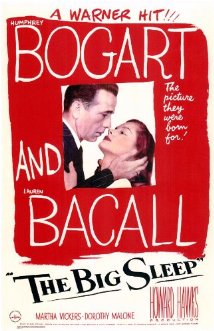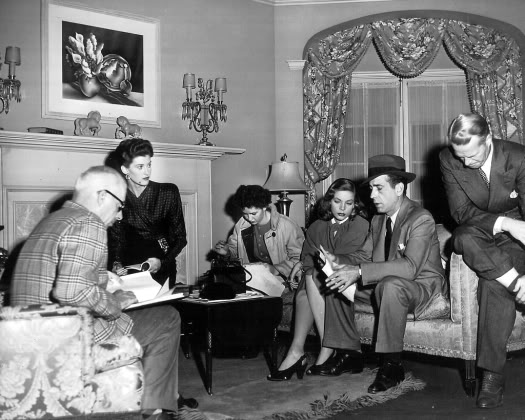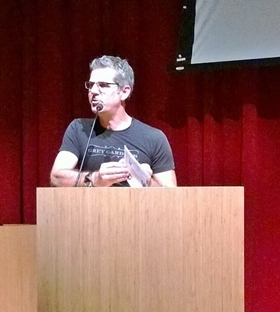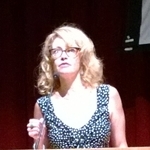I had a great time introducing “The Big Sleep” (1946, Howard Hawks) on Saturday at the West Hollywood Library. Many thanks to event organizers Corey Roskin and Andrew Campbell, who did a great job and gave me a warm welcome.
The free screening was part of WeHo Reads, a noir-themed month-long literary program. Next Saturday, Sept. 20, “Mildred Pierce” will play and on Saturday, Sept. 27, there will be a day of panels, music and film.
Meanwhile, I thought I’d share nuggets of info from my presentation.
***As you probably know, “The Big Sleep” stars Humphrey Bogart and Lauren Bacall, who formed one of Hollywood’s primo power couples, onscreen and off.
***“The Big Sleep” is a hard-boiled detective story, to be sure, but its mood is more upbeat, fun and entertaining than a typical film noir. It doesn’t have an angst-ridden, pessimistic, cynical vibe, nor is it a tale of American vets finding it hard to adjust to civilian life after WWII. Instead, the men are glad to be back home and the women welcome them with open arms. It was time for a little romance and there’s flirtation, risqué banter and innuendo aplenty.
 ***Central to the sexy, sultry tone: Bogart and Bacall, of course. This was the second film they starred in. The first was 1944’s “To Have and Have Not,” where the pair fell in love and she famously lit his cig, also directed by Hawks. There were four B&B movies in total, all for Warner Bros. The other two were: “Dark Passage” (1947, Delmer Daves) and “Key Largo” (1948, John Huston).
***Central to the sexy, sultry tone: Bogart and Bacall, of course. This was the second film they starred in. The first was 1944’s “To Have and Have Not,” where the pair fell in love and she famously lit his cig, also directed by Hawks. There were four B&B movies in total, all for Warner Bros. The other two were: “Dark Passage” (1947, Delmer Daves) and “Key Largo” (1948, John Huston).
***Hawks’ wife, Slim Keith, spotted Bacall, a teenage model, in Harper’s Bazaar. Slim showed her husband and he quickly cast her in “To Have and Have Not.” He told Bogart: “You’re the most insolent man on the screen and I’ve found a girl who’s more insolent than you.”
***“The Big Sleep” started shooting in October of 1944. Hawks, a confident, successful auteur (who later would be much admired by French critics) was sure it would be a straightforward production. Um, not so much.
***“The Big Sleep” was Raymond Chandler’s first novel (1939) and the first novel to feature the character Philip Marlowe, a tough private eye based in Hollywood. The film was the first time Bogart portrayed Marlowe.
***The first time Marlowe appeared in celluloid form was in 1944’s “Murder, My Sweet,” starring Dick Powell. This movie was based on Chandler’s second novel, “Farewell, My Lovely” (1940).
***More than likely, Chandler would have been tapped to write the script for “The Big Sleep,” but he had an exclusive contract with Paramount, which had released “Double Indemnity” earlier that year. (Chandler and director Billy Wilder had adapted “Double Indemnity” from James M. Cain’s novel.)

“The Big Sleep” script is notoriously confusing. Here, director Howard Hawks, far left, and his team try to figure it out. The film’s own backstory is also a bit tangled.
***Hawks hired William Faulkner and Jules Furthman, the team that had adapted Ernest Hemingway’s “To Have and Have Not,” for “The Big Sleep.”
***Also hired was a 28-year-old sci-fi writer named Leigh Brackett. Hawks, a macho type who liked to hunt, fish and shoot with his buddies, was surprised to discover that Brackett was a woman but he was glad to give her a shot. He liked women who could hold their own among manly men. She did fine and had a great career.
***Faulkner decided to divide the work in a strange way: He and Furthman would be one team and Brackett would be another. The two “teams,” working separately, would tackle alternating chapters of the book and slot them together when they’d finished. The script was somewhat disjointed and Hawks took a stab at tweaking it.
***Bacall was just 20 years old and had scant training as an actress when she played spoiled rich girl Carmen Sternwood in “The Big Sleep.” Her female co-stars were Martha Vickers as her little sister, Carmen; Dorothy Malone as a bookstore clerk and Sonia Darrin as a so-called bookstore clerk.
***The book has a serpentine plot and so does the movie. It’s easy to lose track of the narrative but there are seven dead by the end. One day, Bogart asked Hawks who killed the Owen Taylor character (the Sternwood family chauffeur). Hmm, good question. Hawks didn’t know and neither did the writers. Hawks sent Chandler a telegram and he replied that he didn’t know either.
***Hawks sometimes had to shoot around Bogart because the actor was going on drinking benders. Though Bogart had met the love of his life in Bacall, there was a glitch. Still married to his third wife, actress Mayo Methot, he ended the affair with Bacall and he tried to reconcile with Methot. It didn’t go well and Bogart took to binging. Also, there was tension because Hawks was hoping to ignite a romance with his protégée Bacall and she snubbed him.
***All that said, they still managed to have a good time on the film. In fact, Jack Warner sent Hawks this memo: “Word has reached me that you are having fun on the set. This must stop.”
***Hawks was known for fast-paced action and comedy. He also gave rise to the “bromance” before the term existed. So, as I said, this film does not have the brooding, doom-and-gloom feeling that typically characterizes film noir. By the same token, it doesn’t have the intense chiaroscuro visual style (which has its roots in German Expressionism) that so often shapes the look of film noir. Nevertheless, “The Big Sleep,” which was an A-budget title, boasts a top cinematographer: Sid Hickox, who also shot “Dark Passage.” (Max Steiner provided the score.)
***They finished shooting in January 1945. Bogart divorced Methot and married Bacall in May 1945. “The Big Sleep” was shown to U.S. servicemen in the Philippines in August 1945. World War II was ending so Warner Bros. hurried to release movies with war-related narratives. “The Big Sleep” wasn’t timely or topical and could be released at a later date.
***Also, Warner Bros. put “The Big Sleep” on the back burner so as not to compete with Bacall’s second movie: “Confidential Agent” (1945) based on a Graham Greene novel and co-starring Charles Boyer. Unfortunately, though, that film garnered scathing reviews for Bacall.
***Warner Bros. then turned its attention back to “The Big Sleep,” hoping the movie would be able to compensate for the disappointment of “Confidential Agent.” The studio showed it to preview audiences and they wanted more scenes with Bogart and Bacall. So did Bacall’s agent. And, as Mrs. Humphrey Bogart, she now had impressive clout.
***In January 1946, Hawks spent six days reshooting and came up with another version of the film, one that gives us more Bogie and Bacall sizzle. There is also less of Martha Vickers – even though she was quite good, promoting Bacall and recapturing the electric chemistry of “To Have and Have Not” was the priority. The new scenes reportedly were written by one or both of the Epstein brothers, Julius and Philip, of “Casablanca” fame.
***“The Big Sleep” was released on Aug. 31, 1946. The narrative was even less clear than before, but who cares?! We have Bogart and Bacall in top form – flirting and fighting off baddies – in a very entertaining film. Both versions of the movie (as well as a short documentary on the changes) are available from Warner Bros.
***Hawks was once asked what makes a great movie. His answer was three great scenes and no bad scenes. By that definition, “The Big Sleep” surely ranks as a great work.














From FNB readers